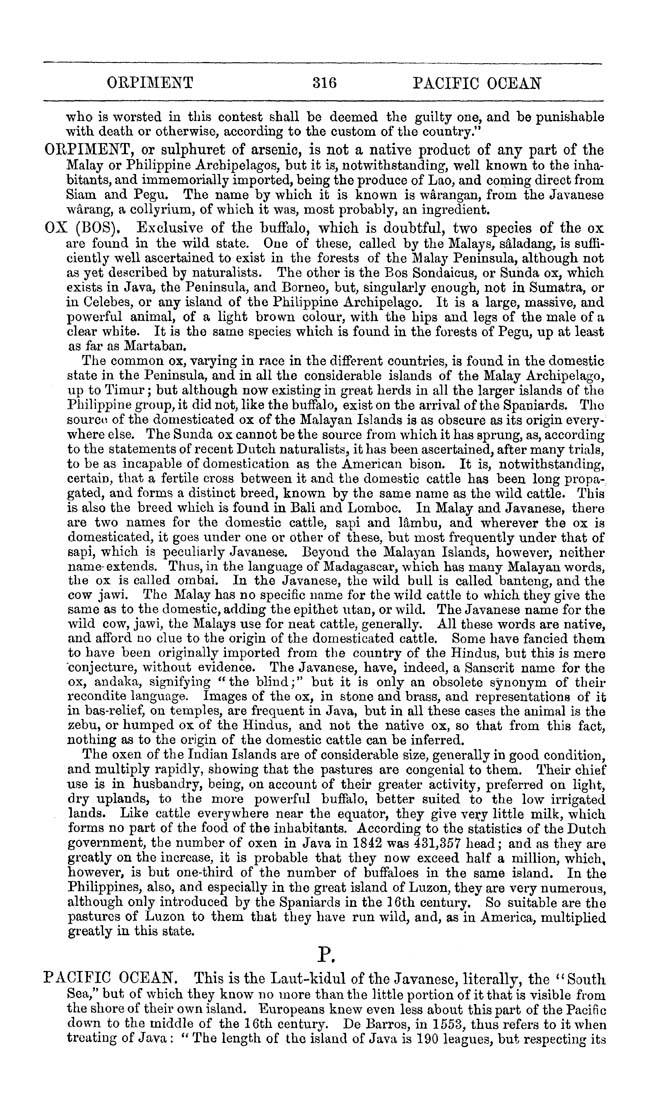ORPIMENT 316 PACIFIC OCEAN
who is worsted in this contest shall be deemed the guilty one, and be punishable
with death or otherwise, according to the custom of the country."
OPtPIMENT, or sulphuret of arsenic, is not a native product of any part of the
Malay or Philippine Archipelagos, but it is, notwithstanding, well known to the inha¬
bitants, and immemorially imported, being the produce of Lao, and coming direct from
Siam and Pegu. The name by which it is known is warangan, from the Javanese
warang, a collyrium, of which it was, most probably, an ingredient.
OX (BOS), Exclusive of the buffalo, which is doubtful, two species of the ox
are found in the wild state. One of these, called by the Malays, saladang, is suffi¬
ciently well ascertained to exist in the forests of the Malay Peninsula, although not
as yet described by naturalists. The other is the Bos Sondaicus, or Sunda ox, which
exists in Java, the Peninsula, and Borneo, but, singularly enough, not in Sumatra, or
in Celebes, or any island of the Philippine Archipelago. It is a large, massive, and
powerful animal, of a light brown colour, with the hips and legs of the male of a
clear white. It is the same species which is found in the forests of Pegu, up at least
as far as Martaban.
The common ox, varying in race in the different countries, is found in the domestic
state in the Peninsula, and in all the considerable islands of the Malay Archipelago,
up to Timur; but although now existing in great herds in all the larger islands of the
Philippine group, it did not, like the buffalo, exist on the arrival of the Spaniards. The
source of the domesticated ox of the Malayan Islands is as obscure as its origin every¬
where else. The Sunda ox cannot be the source from which it has sprung, as, according
to the statements of recent Dutch naturalists, it has been ascertained, after many trials,
to be as incapable of domestication as the American bison. It is, notwithstanding,
certain, that a fertile cross between it and the domestic cattle has been long propa¬
gated, and forms a distinct breed, known by the same name as the wild cattle. This
is also the breed which is found in Bali and Lomboc. In Malay and Javanese, there
are two names for the domestic cattle, sapi and l^mbu, and wherever the ox is
domesticated, it goes under one or other of these, but most frequently under that of
sapi, which is peculiarly Javanese. Beyond the Malayan Islands, however, neither
name- extends. Thus, in the language of Madagascar, which has many Malayan words,
the ox is called ombai. In the Javanese, the wild bull is called banteng, and the
cow jawi. The Malay has no specific name for the w^ild cattle to which they give the
same as to the domestic, adding the epithet utan, or wild. The Javanese name for the
wild cow, jawi, the Malays use for neat cattle, generally. All these words are native,
and afford no clue to the origin of the domesticated cattle. Some have fancied them
to have been originally imported from the country of the Hindus, but this is mere
conjecture, without evidence. The Javanese, have, indeed, a Sanscrit name for the
ox, andaka, signifying "the blind;" but it is only an obsolete synonym of their
recondite language. Images of the ox, in stone and brass, and representations of it
in bas-relief, on temples, are frequent in Java, but in all these cases the animal is the
zebu, or humped ox of the Hindus, and not the native ox, so that from this fact,
nothing as to the origin of the domestic cattle can be inferred.
The oxen of the Indian Islands are of considerable size, generally in good condition,
and multiply rapidly, showing that the pastures are congenial to them. Their chief
use is in husbandry, being, on account of their greater activity, preferred on light,
dry uplands, to the more pow^erful buffalo, better suited to the low irrigated
lands. Like cattle everywhere near the equator, they give very little milk, which
forms no part of the food of the inhabitants. According to the statistics of the Dutch
government, the number of oxen in Java in 1842 was 431,357 head; and as they are
greatly on the increase, it is probable that they now exceed half a million, which,
however, is but one-third of the number of buffaloes in the same island. In the
Philippines, also, and especially in the great island of Luzon, they are very numerous,
although only introduced by the Spaniards in the 16th century. So suitable are the
pastures of Luzon to them that they have run wild, and, as in America, multiplied
greatly in this state.
P.
PACIFIC OCEAN. This is the Laut-kidul of tlie Javanese, literally, the ^' South
Sea," but of which they know no more than the little portion of it that is visible from
the shore of their own island. Europeans knew even less about this part of the Pacific
down to the middle of the 16th century. De Barros, in 1553, thus refers to it when
treating of Java: ** The length of the island of Java is 190 leagues, but respecting its
|








